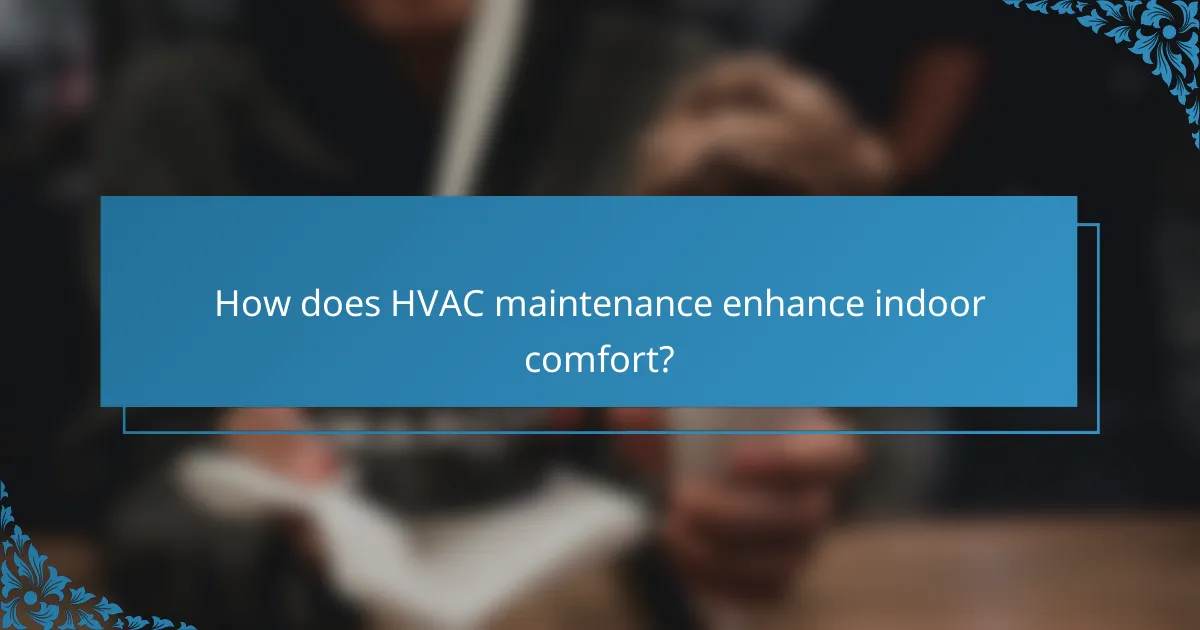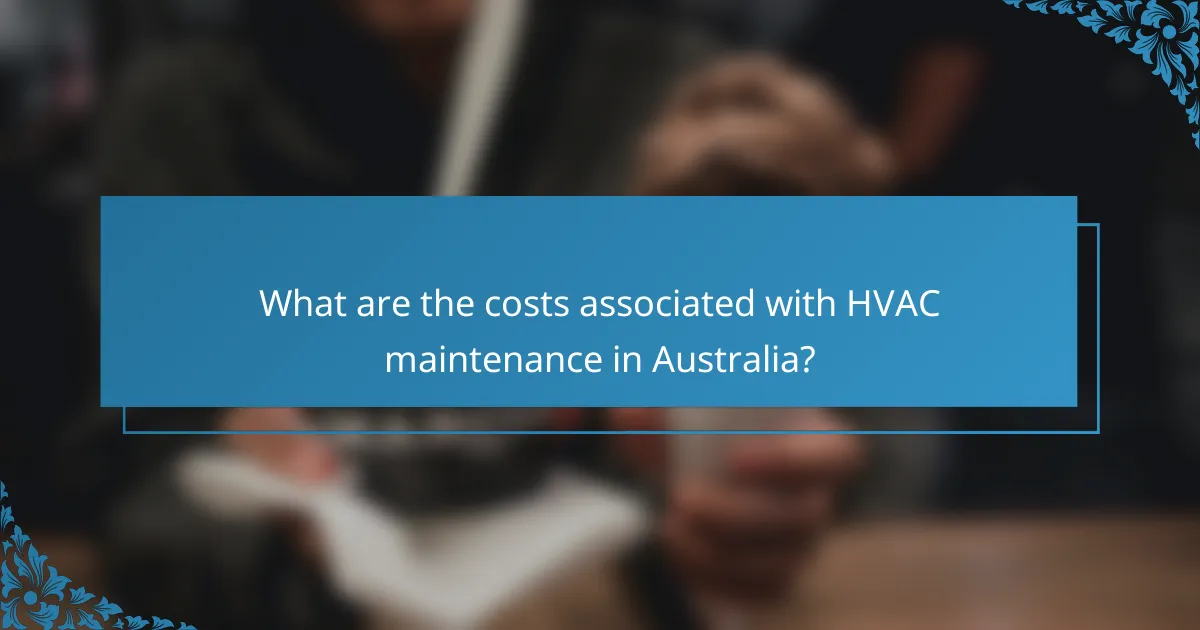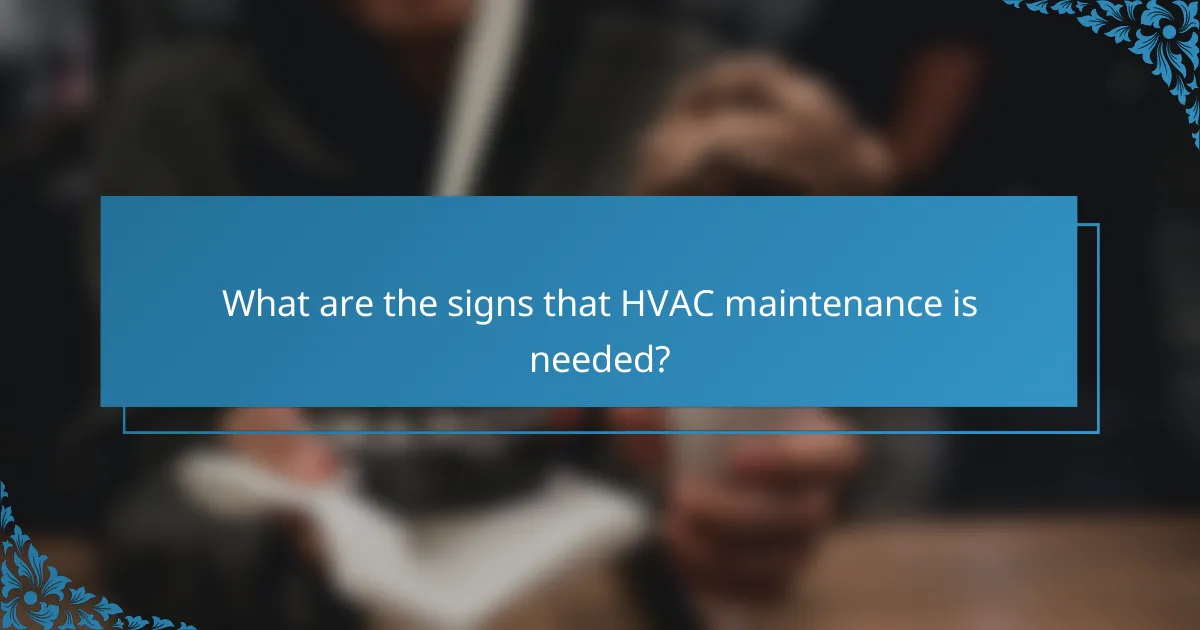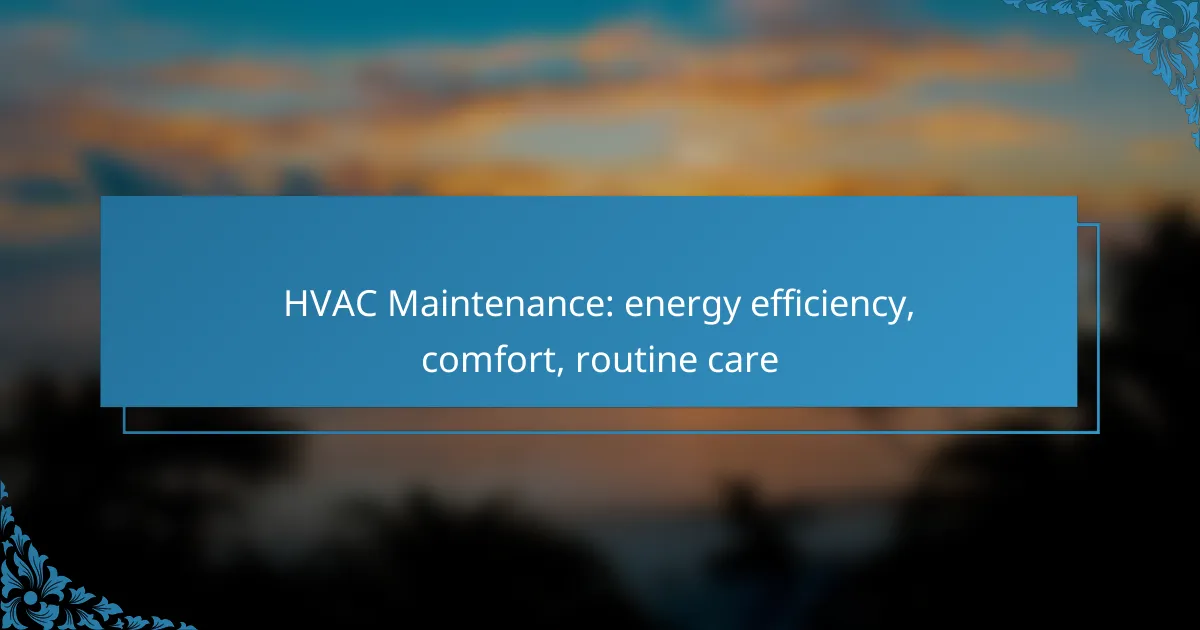Regular HVAC maintenance is essential for enhancing energy efficiency and ensuring optimal comfort in your home. By performing routine care, you can prevent breakdowns, reduce energy bills, and maintain consistent temperatures, ultimately creating a more pleasant living environment. Prioritizing these tasks not only extends the lifespan of your system but also improves indoor air quality and humidity control.

How can HVAC maintenance improve energy efficiency in Australia?
Regular HVAC maintenance significantly enhances energy efficiency by ensuring systems operate at optimal performance. In Australia, this can lead to reduced energy bills and improved indoor comfort, especially during extreme weather conditions.
Regular filter changes
Changing air filters regularly is crucial for maintaining energy efficiency in HVAC systems. Clogged filters restrict airflow, forcing the system to work harder and consume more energy. It is recommended to check and replace filters every one to three months, depending on usage and environmental factors.
Using high-efficiency filters can further improve air quality and system performance. Homeowners should consider investing in filters that capture smaller particles while allowing adequate airflow.
System tune-ups
Annual system tune-ups are essential for optimizing HVAC performance. A professional technician can clean components, check refrigerant levels, and ensure all parts are functioning correctly. This proactive maintenance can improve efficiency by up to 15%.
During a tune-up, technicians may also identify potential issues before they escalate, saving homeowners from costly repairs and energy waste in the long run.
Smart thermostat installation
Installing a smart thermostat can significantly enhance HVAC energy efficiency. These devices learn user preferences and adjust heating and cooling schedules accordingly, reducing energy consumption when the home is unoccupied.
Many smart thermostats also provide energy usage reports, allowing homeowners to track and optimize their energy habits. This technology can lead to savings of around 10-15% on heating and cooling costs.
Insulation improvements
Improving insulation in a home can greatly enhance HVAC efficiency by minimizing heat loss in winter and heat gain in summer. Proper insulation in attics, walls, and floors helps maintain consistent indoor temperatures, reducing the workload on HVAC systems.
Homeowners should consider using materials that meet Australian standards for insulation, such as fiberglass or foam boards, to achieve optimal results. Sealing gaps and cracks can further enhance insulation effectiveness.
Energy-efficient equipment upgrades
Upgrading to energy-efficient HVAC equipment can lead to significant energy savings. Look for systems with high Energy Efficiency Ratings (EER) or Seasonal Energy Efficiency Ratios (SEER) that meet Australian standards.
While the initial investment may be higher, energy-efficient systems typically pay for themselves over time through reduced energy bills. Homeowners should evaluate available rebates and incentives for energy-efficient upgrades in their region to maximize savings.

What routine care is essential for HVAC systems?
Routine care for HVAC systems is crucial for maintaining energy efficiency and comfort in your home. Regular maintenance tasks help prevent breakdowns, extend system lifespan, and ensure optimal performance.
Monthly filter checks
Checking and replacing air filters monthly is vital for HVAC efficiency. Clogged filters restrict airflow, forcing the system to work harder and consume more energy. Depending on usage and filter type, replace standard filters every 1-3 months to maintain optimal airflow.
Consider using high-efficiency particulate air (HEPA) filters, which can capture smaller particles and improve indoor air quality. Always ensure that filters are correctly sized for your system to avoid leaks and inefficiencies.
Seasonal inspections
Conducting seasonal inspections is essential for HVAC systems, ideally before the heating and cooling seasons. A professional technician can identify potential issues, clean components, and ensure that the system operates efficiently. Schedule these inspections at least once a year for optimal performance.
During these inspections, technicians will check for refrigerant leaks, inspect electrical connections, and ensure that all mechanical parts are functioning correctly. This proactive approach can save you from costly repairs later on.
Cleaning condenser coils
Cleaning condenser coils is a critical maintenance task that should be performed at least once a year. Dirty coils can significantly reduce system efficiency, leading to higher energy bills and potential system failure. Use a soft brush or vacuum to remove debris and dirt from the coils.
For optimal results, consider hiring a professional for deep cleaning, especially if the coils are heavily soiled. This maintenance step can improve heat exchange efficiency and prolong the life of your HVAC system.
Checking refrigerant levels
Regularly checking refrigerant levels is important for the efficient operation of your HVAC system. Low refrigerant levels can indicate leaks, which can lead to reduced cooling capacity and increased energy consumption. A qualified technician should handle refrigerant checks and any necessary recharges.
Maintaining proper refrigerant levels ensures that your system operates within manufacturer specifications, enhancing both comfort and energy efficiency. If you notice inconsistent temperatures, it may be time to check refrigerant levels.
Testing thermostat accuracy
Testing the accuracy of your thermostat is essential for maintaining comfort and energy efficiency. An inaccurate thermostat can lead to improper heating or cooling, causing discomfort and increased energy costs. Regularly verify that the thermostat settings match the actual room temperature.
Consider upgrading to a programmable or smart thermostat, which can optimize energy use by adjusting temperatures based on your schedule. This investment can lead to significant savings on your energy bills over time.

How does HVAC maintenance enhance indoor comfort?
Regular HVAC maintenance significantly improves indoor comfort by ensuring optimal system performance. This includes maintaining consistent temperatures, enhancing air quality, and controlling humidity levels, all of which contribute to a more pleasant living environment.
Consistent temperature control
Consistent temperature control is crucial for indoor comfort, as it prevents fluctuations that can lead to discomfort. Regular maintenance, such as cleaning filters and calibrating thermostats, helps achieve stable temperatures throughout the home.
To maintain consistent temperature control, consider scheduling seasonal check-ups for your HVAC system. This proactive approach can help identify issues before they escalate, ensuring your system operates efficiently year-round.
Improved air quality
HVAC maintenance plays a vital role in improving indoor air quality by reducing dust, allergens, and pollutants. Regularly changing filters and cleaning ducts can significantly decrease the presence of harmful particles in the air.
For optimal air quality, replace filters every 1-3 months, depending on usage and filter type. Additionally, consider using high-efficiency particulate air (HEPA) filters, which can capture smaller particles and enhance overall air cleanliness.
Reduced humidity levels
Effective HVAC maintenance helps regulate humidity levels, which is essential for comfort and health. High humidity can lead to mold growth and discomfort, while low humidity can cause dry skin and respiratory issues.
To manage humidity, ensure your system’s dehumidification settings are functioning correctly. Regularly inspect and clean condensate drains to prevent clogs that can lead to excess moisture in your home.
Noise reduction
HVAC systems can generate noise that disrupts indoor comfort. Regular maintenance can help identify and address sources of noise, such as loose components or worn-out parts, leading to a quieter environment.
To minimize noise, schedule routine inspections to tighten loose parts and lubricate moving components. If your system is particularly loud, consider upgrading to a quieter model or adding sound-dampening materials in the installation area.

What are the costs associated with HVAC maintenance in Australia?
The costs associated with HVAC maintenance in Australia can vary significantly based on service type, equipment, and location. Regular maintenance can help prevent costly repairs and improve energy efficiency, making it a worthwhile investment for homeowners.
Average service fees
In Australia, average service fees for HVAC maintenance typically range from AUD 100 to AUD 300 per visit. Factors influencing these costs include the complexity of the system and the technician’s experience. It’s advisable to obtain quotes from multiple providers to ensure competitive pricing.
Cost of replacement parts
The cost of replacement parts for HVAC systems can vary widely, depending on the component and brand. Common parts like filters, thermostats, and motors can range from AUD 20 to AUD 500. It’s essential to consider both the price and the quality of parts when making replacements to ensure long-term reliability.
Annual maintenance plans
Many HVAC companies in Australia offer annual maintenance plans, which can cost between AUD 200 and AUD 600. These plans often include regular inspections, priority service, and discounts on repairs. Investing in a maintenance plan can lead to lower overall costs by preventing major breakdowns.
Potential savings from energy efficiency
Regular HVAC maintenance can lead to significant energy savings, often reducing energy bills by 10% to 30%. Keeping systems clean and well-tuned enhances efficiency, which not only lowers costs but also extends the lifespan of the equipment. Homeowners should consider these savings when evaluating maintenance expenses.

What are the signs that HVAC maintenance is needed?
Signs that HVAC maintenance is needed include unusual noises, inconsistent temperatures, and increased energy bills. These indicators suggest that your system may not be operating efficiently, which can affect both comfort and energy costs.
Unusual Noises
If your HVAC system starts making strange sounds like banging, hissing, or grinding, it’s a clear sign that maintenance is required. These noises can indicate loose components, worn-out parts, or even airflow issues that need immediate attention.
Regularly listen for these sounds, especially during startup and shutdown phases. If you notice persistent noise, consider scheduling a professional inspection to avoid further damage.
Inconsistent Temperatures
Inconsistent temperatures throughout your home can signal that your HVAC system is struggling to maintain airflow or temperature balance. This may be due to blocked ducts, malfunctioning thermostats, or issues with the unit itself.
To address this, check for blocked vents and ensure that your thermostat is functioning correctly. If problems persist, a technician can help diagnose and resolve underlying issues.
Increased Energy Bills
A sudden spike in energy bills can indicate that your HVAC system is working harder than it should. This inefficiency may stem from dirty filters, refrigerant leaks, or aging equipment that requires maintenance or replacement.
Regularly inspect and replace air filters every few months to maintain efficiency. If energy costs continue to rise despite routine care, consult a professional to evaluate your system’s performance.
